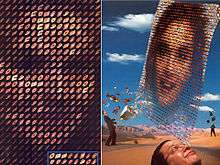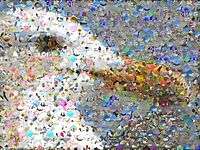Photographic mosaic
In the field of photographic imaging, a photographic mosaic, also known under the term Photomosaic, a portmanteau of photo and mosaic, is a picture (usually a photograph) that has been divided into (usually equal sized) tiled sections, each of which is replaced with another photograph that matches the target photo.[1] When viewed at low magnifications, the individual pixels appear as the primary image, while close examination reveals that the image is in fact made up of many hundreds or thousands of smaller images.[1] Most of the time they are a computer-created type of montage.
There are two kinds of mosaic, depending on how the matching is done. In the simpler kind, each part of the target image is averaged down to a single color. Each of the library images is also reduced to a single color. Each part of the target image is then replaced with one from the library where these colors are as similar as possible. In effect, the target image is reduced in resolution (by downsampling), and then each of the resulting pixels is replaced with an image whose average color matches that pixel.
In the more advanced kind of photographic mosaic, the target image is not downsampled, and the matching is done by comparing each pixel in the rectangle to the corresponding pixel from each library image. The rectangle in the target is then replaced with the library image that minimizes the total difference. This requires much more computation than the simple kind, but the results can be much better since the pixel-by-pixel matching can preserve the resolution of the target image.
Originally, the term photomosaic referred to compound photographs created by stitching together a series of adjacent pictures of a scene. Space scientists have been assembling mosaics of this kind since at least as early as the Soviet Union space satellite missions to the moon in the late 1950s.[2] The name photomosaic and an implementation concept were trademarked by Robert Silvers' Runaway Technology, Inc.[3]
History

- 1993 Joseph Francis, working for R/Greenberg Associates in Manhattan, is believed to be the inventor of the modern-day computer-generated colour image versions. His Live from Bell Labs poster created in 1993 used computer-themed tile photographs to create a mosaic of a face ( Ryszard Horowitz/ Photography and Art Direction, Robert Bowen/ Digital Artist). He went on to create a mosaic for Animation Magazine in 1993, which was repeated in Wired Magazine (November 1994, p. 106). Francis has said on his "History of Photo Mosaics" webpage that his interest in developing these techniques further was in part stimulated by the work of artist Chuck Close.
- 1994 Dave McKean creates an image for DC Comics, a mosaic of a face made from photos of faces, although this is believed to be created manually using Photoshop.
- 1994 Adam Finkelstein and Sandy Farrier create a mosaic of John F. Kennedy from parts of Marilyn Monroe pictures. The result was displayed in the Xerox PARC Algorithmic Art Show in 1994.
- 1994 Benetton: AIDS - Faces mosaic. Over one thousand young peoples' portraits from all over the word computer-processed spell out the word AIDS.
- 1995 The Gioconda Sapiens, a face with ten thousand faces, was presented to the public in April 1995 (Spain, Domus museum). This was the first large photographic mosaic, using photographs of 10,062 people from 110 countries to make the Mona Lisa.
- 1995 Adam Finkelstein (published mosaic in Mossy Bits) creates a mosaic of the oil painting American Gothic from images collected from the Web in early 1995.
- 1995 Robert Silvers creates an algorithm for generating Photomosaics programmatically and goes on to trademark the term Photomosaic and patent his process for creation of Photomosaics in 1997.
Artistic aspects
There is debate over whether Photomosaics are an art or mere technique.[4] The making of a photomosaic is sometimes paralled and compared to forms of artistic appropriation, like literary assemblage.[5]
Artists such as David Hockney, Christopher Kates and Pep Ventosa have pioneered their own photographic mosaic techniques where multiple photographs are taken of a scene and then pieced together again to create a cohesive image.
Trademark and intellectual property of the concept
Robert Silvers, a Master's student at MIT, filed for a trademark on the term Photomosaic on September 3, 1996. This trademark was registered on August 12, 2003.[3]
Silvers also applied for a U.S. patent on the production of Photomosaics on January 2, 1997, which was granted as US 6137498 in October 2000 and has been assigned to Runaway Technology, Inc. Patent applications in other countries were also filed, and patents granted include EP 0852363, JP 10269353, CA 2226059, and AU 723815B. He is quoted as saying: "By being granted this patent in the United States and other countries, we can protect our proprietary innovations and continue to make unique artwork." [6] In September 2008, the Public Patent Foundation filed a formal request with the United States Patent and Trademark Office (USPTO) to review certain claims in the US 6137498 on photomosaics. The request was granted and a reexamination proceeding ensued. On August 31, 2010, the USPTO issued a Reexamination Certificate confirming the patentability of all claims in the patent which were amended to refer to shape matching (a feature that contributes to the high resolution of photomosaics).
There are a number of other commercial companies that create mosaics with photos. Since there has been no litigation of these patents, these companies must therefore either use processes that do not infringe on the particular claimed process, have licenses under the patents, or are infringing those patents but Runaway Technology has chosen not to bring infringement proceedings.
Silvers' patent may be regarded as a software patent, a subject over which there is a great deal of debate. For example, Article 52(2)(c) EPC states that "programs for computers as such" are not regarded as patentable inventions. Nevertheless, current practice relating to computer-implemented inventions under the EPC means that a process that provides a technical effect may be patented even if it is implemented by a computer.
The UK patent deriving from EP 0852363 became the subject of revocation proceedings in July 2006.[7] In September 2009, the UK Intellectual Property Office (UK-IPO) decided that the patent should not be revoked and terminated the proceeding. This decision was made by the UKIPO and not the European Patent Office (EPO) which originally granted the patent since no opposition to the European patent was filed within the nine-month post-grant period.[8]
Video mosaic
Photographic mosaics are typically formed from a collection of still images. A more recent phenomenon, however, has been video mosaics which assemble video clips rather than still images to create a larger image. The closing credits of the 2005 PlayStation 2 game God of War, for example, incorporates a still image of the main character, Kratos, formed from a number of in-game videos.
The term "video mosaic" also describes a large still image made from adjacent frames of video, such as those from video shots of geographic features like roads or cities. A mosaic of the video's relevant frames replaces the full video, saving time and bandwidth, since the stills are much smaller.
See also
| Wikimedia Commons has media related to Photomosaics. |
Notes
- 1 2 Cartwright (2007) p.102 quote:
Photographic mosaic, also known as Photomosaic, a portmanteau of photo and mosaic, is a picture that is divided into small sections. When viewed as a whole, it appears to be one image, when in fact the image is made up of hundreds or even thousands of smaller images.
- ↑ Wilhelms, Don E. (1993). To a Rocky Moon: A Geologist's History of Lunar Exploration (PDF). University of Arizona Press. pp. ii (Front Matter).
- 1 2 "Trademark information for Trademark 75159436". US Trademark Office. Retrieved 2007-08-16.
- ↑ Silvers (2000) quote: "More than anything else people ask me whether Photomosaics are an art or a science. l tell them that Photomosaics, like any art in formative stage, has elements of both."
- ↑ Menke (2008) p.232 quote:
[In Rudyard Kipling's 1902 science-fiction short story "Wireless"] we recognize that the tale's marshalling of realistic particulars has also been a systematic importation of details from Keats's poetry and life history [...] The tale's elaborate descriptions were really Keats's pre-scriptions all along. As in a photomosaic image, the elements of the story that make it seem recognizable and real turn out to be chosen from an artificially constrained palette of appropriations; examined closely, each realistic detail reveals itself as a micro-quotation from that collection.
- ↑ Silvers, Robert. "Robert Silvers | Corporate | Patents". Runaway Technology, Inc. Retrieved November 12, 2011.
- ↑ Using the UK Patents Status Enquiry for EP0852363 provides full details on the current status of the patent.
- ↑ Welcome to epoline
References
- Cartwright, Angela (2007) Mixed Emulsions: Altered Art Techniques for Photographic Imagery
- Francis, Joseph History of Photo Mosaics
- Menke, Richard (2008) Telegraphic realism: Victorian fiction and other information systems
- Silvers, Robert (2000) Photomosaic portraits
- A Short History of PhotoTiled Pictures includes a sample of Dave McKean's 1994 DC Comics photographic mosaic.
